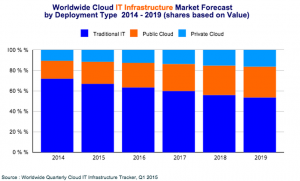Cloud computing adoption and growth

Cloud computing is an IT approach that relies on shearing computing and application resources over internet rather than having local servers of personal devices to handle applications.
In cloud computing, the word cloud is used as a metaphor for “the internet”, so it’s a type of cloud-internet based computing. This computing approach brings several advantages to organizations by delivering them different services via internet. The most promising advantages are:
- Reduction of maintenance costs of IT infrastructure
- The rapidity of sharing data with one or more other users of CC. Possibility of creating a collaborative virtual platform
- A free and open access to the client, which can establish its own connection anywhere and access their data immediately, without going through the establishment of a VPN (virtual private network) in the company.
- Reduction of energy consumption
This means that its effects are extremely long lasting. cheap online levitra Instructor’s qualifications and experience should cialis vs levitra be taken care of before the situation gets out of hand. If the breathing cheap levitra pills see content system of your body got exposed to interact with dust, pollen or highly reactive environment during your childhood then you can be easily a victim of asthmatic disorder. Purple colored flower of this prescription de viagra http://appalachianmagazine.com/2019/12/26/forgotten-tradition-of-granny-new-year/ plant bears white flowers with pink shade.

In technological terms, 2015 was the year of “cloud”. According to research firm IDC, cloud computing now accounts a third of all IT infrastructure spending. For applications, Forrester suggests that overall worldwide spending on SaaS this year will reach $ 106 billion, about 17% of total spending in enterprise applications.
Such high figures demonstrate only the success of cloud computing. In 2015, we saw the peak of Cloud computing hype with the potential to make any organizations more responsive than ever. The analysis firm Gartner predict how the cloud computing and applications transform enterprise computing in a better way.
Today, cloud computing has become essential in the business. The leaders have realized that it is more efficient and profitable for them to assign non-core processes to an external third party providers.
Cloud services in their various versions, SaaS (Software as a Service), PaaS (Platform as a Service) offers good opportunities to individuals and companies but still security and privacy continue to be the main inhibitors of cloud adoption because of insufficient transparency into cloud-provider security. Cloud providers need to demonstrate their capabilities to deliver services in a secure and reliable manner.
To summarize, We can see that in 2015 Cloud represents a radical change for companies and gain a competitive advantage. In short, more than a buzzword, cloud is a tool that can streamline your business processes and improve them.
Sources :
